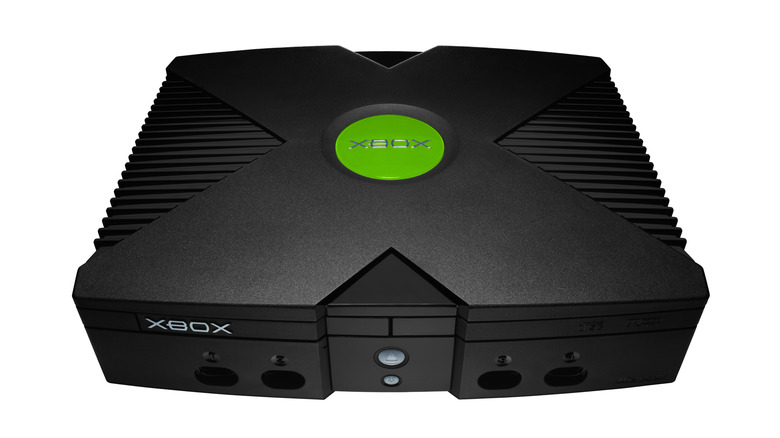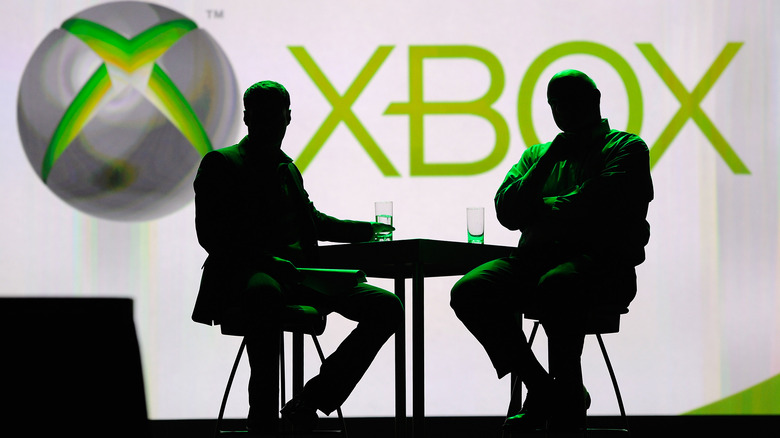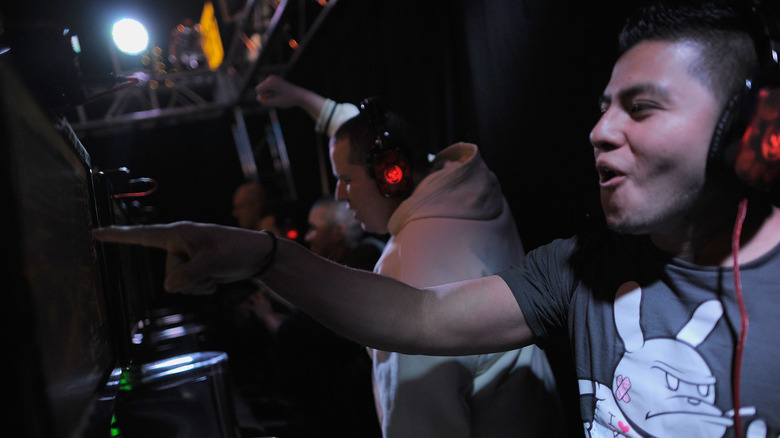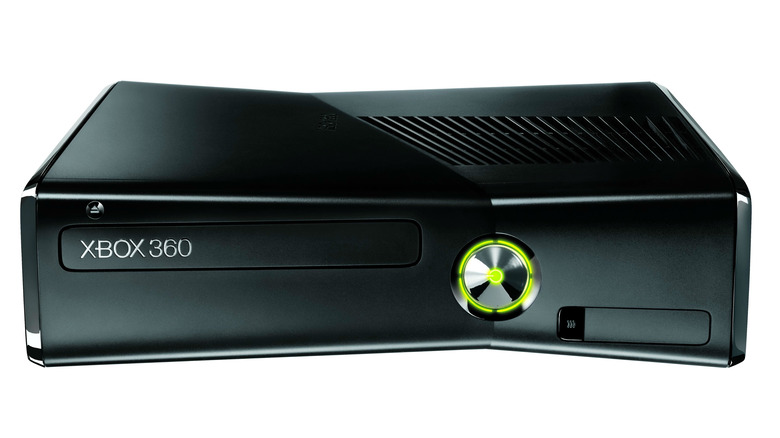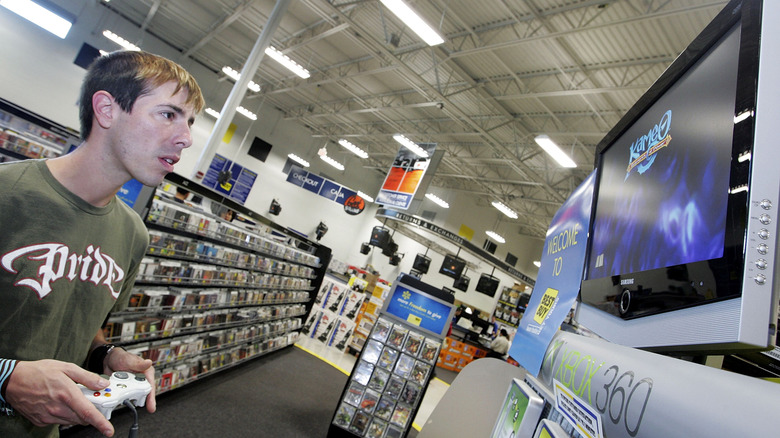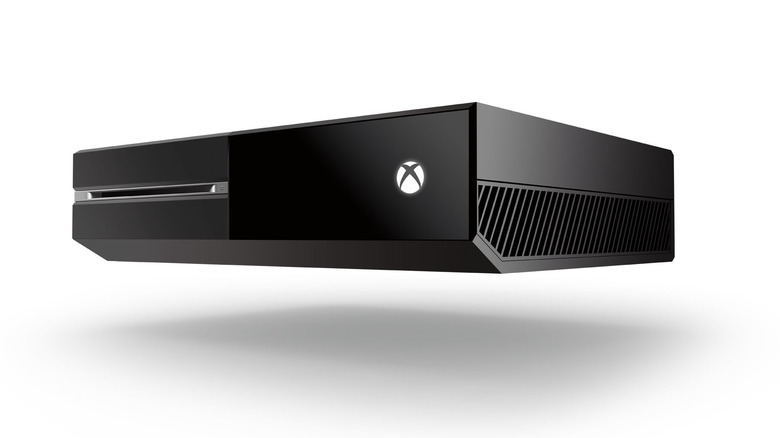The Untold Truth Of The Red Ring Of Death
When you think back through the history of Xbox, what comes to mind? You may remember the original Xbox: the first home of Halo and the launch platform for Xbox Live. Or you may remember the Xbox 360, which brought us the Gears of War franchise, Summers of Arcade, and one of the longest console lifespans in recent memory.
Oh, and hey, speaking of lifespans: do you remember the Red Ring of Death? The sequence of three red LED lights that meant your Xbox 360 had suddenly become a doorstop? The Red Ring of Death was a huge deal for several years following the Xbox 360's launch, and the deeper story behind this famous hardware failure is downright fascinating. Below, we take a closer look at what exactly the Red Ring of Death was, how Microsoft handled the issue, and how fear of more red rings inspired Microsoft's later console designs.
It all starts with the original Xbox.
Microsoft's first console was ugly, but it worked
The original Xbox was a hulking monstrosity. It took up a lot of room, it was heavy, and it stuck out like a sore thumb. "Xbox was too big. Xbox was ugly," said Robbie Bach, the former head of Xbox. "It was our ugly, but it was still not a gorgeous thing."
Given the Xbox looked less like a svelte piece of tech and more a bulky Betamax player, one might conclude that design wasn't the first priority when it was built. And that would be correct. Bach revealed that the design approach taken by the original Xbox team was focused first on parts. The components were selected for the console, and the outer shell was designed once everyone knew what would be going inside. When all was said and done, the Xbox was large, and it wasn't the prettiest console in the world, but it worked.
Microsoft handled the design of the Xbox 360 differently.
"We started with design at the front of the process, and we said, 'This has to be designed with a designer's sensibility.'" In essence: the console's case was designed first, and Microsoft engineers then had to make everything fit. This approach is thought to have contributed to Xbox 360 hardware failures.
A whole lot of Xbox 360s started to fail
It started with a trickle; a few forum posts here and there, published by Xbox 360 customers who were all experiencing the same issue with their console. When powering the system on, they were greeted not by the typical green glowing lights on its front, but instead, by an ominous red circle.
The issue, according to Microsoft's support documentation, signaled some kind of hardware failure within the console or its power supply. The console displayed a "System Error," wouldn't load the Xbox 360 dashboard, and wouldn't load games. And as time wore on, what first appeared to be an isolated number of instances soon grew in size.
The red ring wasn't just showing up on a couple of consoles: it was showing up on a lot of consoles. YouTube, only a few years old at the time, soon filled up with tips and tricks for dealing with the issue. And video game blogs and tech news sites picked up the story, and Microsoft's support line seemed to struggle with the influx of reported issues.
As reports of what was dubbed the "Red Ring of Death" piled up, Microsoft increasingly came under fire from both the press and its customers. Something had to be done. A few the most important people at Microsoft, and within the Xbox division, came together to hash it all out and, hopefully, solve the problem.
One meeting ultimately decided the future of Xbox
With the Red Ring essentially dominating the narrative surrounding the Xbox 360, the entire Xbox brand seemed to be on the ropes. It would take a major move to help Microsoft restore the credibility and trust it had built up with its customers, and such a move could only be made by the biggest players associated with the console.
Microsoft CEO Steve Ballmer, President of Entertainment & Devices Robbie Bach, and VP of Interactive Entertainment Peter Moore met to decide just how they would respond. Peter Moore has spoken about the meeting on several occasions since leaving Microsoft in 2007. "I said, 'if we don't do this, this brand is dead.'" Moore laid out a plan for Ballmer: one that required Microsoft to invest heavily in recalling, repairing, and shipping consoles back — all without any cost to consumers.
The cost would be a staggering $1.15 billion.
According to Moore, Ballmer didn't give it a second thought; after all, the Xbox brand was on the line. He approved it. "I'll never forget that moment," Moore said. "If you're an Xbox gamer, you can thank Steve Ballmer for not even hesitating ... If we hadn't made that decision there and then, and tried to fudge over this problem, then the Xbox brand and Xbox One wouldn't exist today."
Peter Moore published an open letter apologizing to Xbox 360 customers
Before kicking off his plan to make amends with Xbox 360 gamers, Peter Moore first felt compelled to apologize. The Xbox 360 had been out for nearly a year and a half when Moore penned an open letter to Xbox customers, officially acknowledging the Red Ring of Death — and the hardware failures associated with it — as a widespread issue.
"We have been following this issue closely, and with on-going testing have identified several factors that can cause a general hardware failure indicated by three flashing red lights on the console," Moore stated. "To address this issue, and as part of our ongoing work, we have already made certain improvements to the console.
"We are also implementing some important policy changes intended to keep you in the game, worry-free."
Those policy changes, of course, were part of the plan Moore had cleared with Microsoft CEO Steve Ballmer: the plan that would cost Microsoft a pretty significant chunk of change, but would hopefully make things right with customers and help save the Xbox brand.
It would be unlike anything the video game industry had ever seen.
Microsoft kicked off an unprecedented recall and replacement plan
Microsoft was aware a substantial number of Xbox 360s were having hardware issues, and not just those already sold; consoles on shelves at retailers were essentially ticking time bombs. The company needed to cover as many consoles — and take care of as many customers — as possible, regardless of when they purchased their Xbox 360.
Microsoft extended its Xbox 360 warranty from its original one year period to a pretty remarkable three years. This meant that, if you purchased an Xbox 360 console and experienced the Red Ring of Death problem at anytime within a three year window, Microsoft would replace your system at no cost.
Not only that, the company would also pay your shipping costs in both directions, and would work to get you a new or repaired console as quickly as possible. "I always remember $240m of that [recall program total] was FedEx," said Peter Moore. "Their stock must have gone through the roof for the next two weeks." Finally, Microsoft offered to reimburse anyone who'd previously paid out-of-pocket for repairs to their Xbox 360.
In interviews shortly after the announcement, Moore stated that changes were being made to the Xbox 360 hardware to prevent further red ring issues from happening. Unfortunately, we'd soon learn that those changes weren't enough.
And yet, the red ring issue raged on
If anything, the first year or two after Microsoft announced its extended warranty showed just how many Xbox 360s were suffering from hardware defects. The problem could strike at any time, as the team at CNET learned. They watched their pre-launch Xbox 360 suddenly devolve into red-ring status randomly while playing Call of Duty 4, despite it never having issues before. That occurred in Fall 2007.
And then there was the story of Andy Phifer, who all the way in 2009 — two years after Microsoft had extended warranties and claimed to have fixed the hardware — was still having problems with the console. In total, Phifer sent faulty, red-ring-stricken systems back to Microsoft three times. And each time, he got an Xbox 360 in return that had the problem right out of the box.
This news clip can tell you a lot about the mood surrounding the Xbox 360, even after the company had made its grand announcement and extended the console's warranty. It was clear, despite any changes Microsoft made, that hardware problems were still a concern, and no amount of swapping systems would make the issue go away.
Microsoft needed a major hardware change, pronto.
A redesigned console finally killed off the Red Ring of Death for good
In 2010, after years of repairing and/or exchanging massive numbers of Xbox 360 consoles, Microsoft unveiled a completely new design called the Xbox 360 (S). This new hardware iteration brought several changes to the platform, including a capacitive touch power button, integrated support for WiFi, and support for Microsoft's new Kinect peripheral.
What it did most importantly, however, was eliminate the hardware issues that had been causing the red ring to show up in the previous design. "It wasn't really until we shipped the next form factor of the product that the [Red Ring of Death problem] was completely gone," Robbie Bach said in an interview with Business Insider.
Microsoft, perhaps in an attempt to leave the problem in the past, opted to leave the circle of red LED lights out of the new design entirely. The Red Ring of Death was finally dead.
The exact cause of the Red Ring of Death has never been revealed
A survey conducted by Game Informer years after the Xbox 360 launch found that, among 5,000 respondents, an astounding 54.2% had experienced a hardware failure with their Xbox 360s. Microsoft opted not to dispute that figure. Not only that, but going back to when the company first identified the string of failures and initiated its extended warranty, it never — not once — revealed what was actually causing the Red Ring of Death to occur.
Outside analyst Bryan Lewis offered his take on why Microsoft had so many problems with the Xbox 360: "Microsoft wanted to avoid an ASIC vendor," meaning the company chose to design its graphics chip in-house.
Once it came time to design the Xbox 360 (S) model, however, Microsoft went back and designed its chip the way it should have all along — with the help of an ASIC vendor. This is, Lewis believes, the reason why newer Xbox 360 models no longer have the same hardware issues the past models did.
Again, this is all just unconfirmed industry speculation. Now that we've moved on to a new generation, we may never know for sure.
The lesson Microsoft learned is evident in the Xbox One's design
Fun fact: the first-generation Xbox One console is actually the largest console (in area) Microsoft has ever released.
This may surprise you, and you maybe tempted to Google the dimensions of the original Xbox console to fact-check the above statement. But rest assured: it checks out, and it speaks to the fear that Microsoft felt when it came time to design its next system. Microsoft did not want another Red Ring of Death fiasco. So designers and engineers worked together to ensure all the components inside the Xbox One console had plenty of room to breathe.
The approach seems to have worked out. The Xbox One has not fallen victim to any of the pitfalls encountered by its predecessor. And the design choice to go larger initially gave Microsoft time to perfect the smaller designs found in the Xbox One S and, later, the Xbox One X.
There's no telling when Microsoft's next Xbox console will arrive to help usher in a new generation of gaming. But one thing is for certain: when it comes to hardware design, Microsoft seems determined to avoid making another $1 billion mistake.

